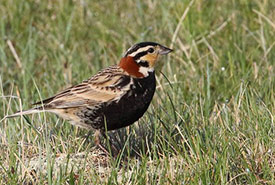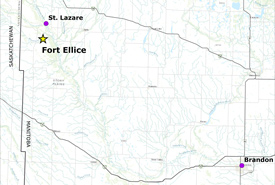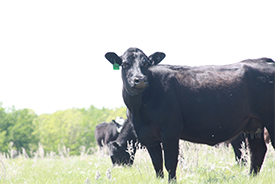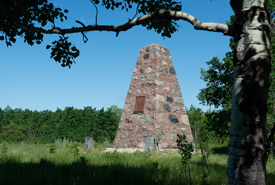Fort Ellice: A Hidden Gem

Chestnut-collared longspur (Photo by Christian Artuso, iNaturalist, CC BY-NC-ND 4.0)
Breathtaking natural beauty
More than 90 per cent of Manitoba’s prairie grasslands have been lost.
In fact, grasslands are one of the most endangered ecosystems in the world, and they continue to disappear at an alarming rate. It is estimated that we lose an additional 59,489 hectares every year.
The Fort Ellice 3 project is a rare conservation opportunity. Surrounded by the Nature Conservancy of Canada’s (NCC's) existing Fort Ellice project and the 15,783-hectare Ellice/Archie Community Pasture, this 261-hectare parcel of land is the key land holding needed to complete one of the last large intact expanses of native prairie grassland in Manitoba.

Fort Ellice Context Map (by NCC)
Grasslands, like those on Fort Ellice 3, have long been synonymous with Canada’s Prairie provinces. Grasslands buffer our waterways, sequester carbon, provide habitat for pollinators and are the foundation of sustainable ranching economies in rural communities.
The conservation of Fort Ellice 3 will complete the conservation of 2,190 hectares of species-rich land comprised of mixed-grass prairie, aspen forests, riverbank and floodplain forests, sandhill prairie and sand dunes, wetlands, streams, freshwater springs and willow shrublands. Large mammals, like elk, moose and Canada lynx, roam the property. Threatened birds, such as Sprague’s pipit and chestnut-collared longspur, depend upon the unique grassland habitat for survival.
Fort Ellice 3, with its breathtaking natural beauty enhanced by the Assiniboine River and Beaver Creek valleys, is a national treasure.
Protecting Manitoba’s biodiversity
When it comes to biodiversity, the Fort Ellice project is truly awe-inspiring, with its wide variety of ecosystems, including sandhill prairie, mixed-grass prairie, oak savannah, deciduous forests, wetlands and streams.

Cow on Fort Ellice property. Photo by NCC.
Many species of provincial and national conservation concern occur on the lands surrounding Fort Ellice 3. The majority of these species are found only in sandhill prairie/mixed-grass prairie habitat, including chestnut-collared longspur, loggerhead shrike and Baird’s sparrow.
The property is home to more than one rare and distinctive habitat. Calcareous fens are peat-accumulating wetlands that depend on a constant supply of groundwater rich in minerals. Tufa mounds, also known as “petrifying springs,” are geological formations created by a deposit from springs or streams of groundwater. Both are important habitat for a diversity of species, and both can be found here.

Fort Ellice cairn (Photo by T. Fricke)
A place for people to connect throughout history
The Fort Ellice project lies along the Carlton Trail. This historical pathway is responsible for the western expansion of Canada where, during the 18th and 19th century, several trading post forts were constructed. The fort, after which this property is named, was originally established as a Hudson’s Bay Company trading post in 1831. Today, nature has reclaimed the land and only a subtle reminder of the fort is left. Its preservation, however, is an important cultural and historical contribution to Manitoba.
NCC also recognizes the rich Indigenous history of the Fort Ellice project and respects and seeks to protect the cultural integrity as well as the plants and wildlife found here.
NCC partners with Parkwest School Division and the Waywayseecappo Off-Campus School to achieve tangible conservation on the Fort Ellice project. Participating students are trained as “citizen scientists” through workshops and actual field work, helping them connect with the land.
Grazing is an important land management tool on the Fort Ellice property. NCC’s collaboration with farmers and other landowners makes it possible to develop effective land management programs. These programs, including grazing, benefit both the local livestock industry and the native grasslands.
A virtual tour
You can experience Fort Ellice without leaving the comfort of your home. Explore this stunning landscape through Google Trekker, a backpack-mounted 360-degree camera that uses the same technology as Google Street View.
We need your help
Please join us and support the Nature Conservancy of Canada’s grassland conservation initiative to conserve projects like Fort Ellice. This is your chance to be part of the conservation of this important historical place, a place that provides a connection to the land for today, and for tomorrow.
With your donation, we will continue to work with local communities, restore wildlife habitat, remove invasive species and manage the land and water for improved overall ecological health.
Funds raised throughout the grassland initiative will also contribute to the long-term stewardship of new and existing conserved areas as well as critical science and research.
“To wander this land is to develop an awe and passion for the plant and animal species that evolved in an ecosystem now almost completely displaced. Let’s do our part in ensuring a beautiful, valuable and significantly sized remnant remains.” - Ken and Sharon Mould, Conservation Champions
Donations may be pledged over time and made by cash, credit card, cheque, or securities transfer. All or a portion of your gift may be committed to our provincial stewardship endowment fund, which helps to ensure the long-term care and management of NCC’s properties in Manitoba. Up to 20% of your gift may support activities that advance NCC’s mission in Manitoba. In the event that this project becomes fully funded, your gift will be directed to NCC’s next urgent priority in Manitoba.






